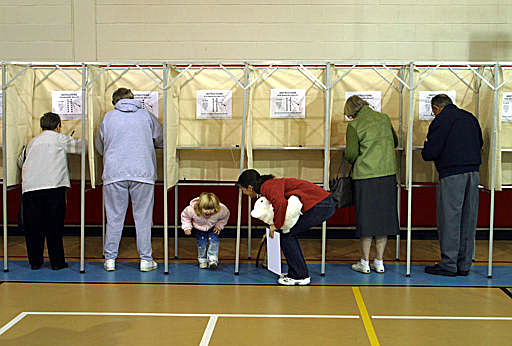Voters Make Quick, Shallow Decisions, Study Suggests

Voters can judge a politician's competence in the blink of an eye—or so they think they can, a new study suggests.
Previous research hints that voters go for the most competent candidates, but the new analysis reveals people can forge steadfast opinions simply by glancing at a candidate's picture. The study highlights some of the shallow behaviors of a sizeable chunk of the voting population, said co-author Alexander Todorov, a psychologist at Princeton University.
"People are looking for the right information about a candidate, they're just looking in the wrong place," Todorov said. "We're seeing that snap judgments play a bigger role in voting than we thought."
The study's findings are detailed in the Oct. 22 issue of the journal Proceedings of the National Academy of Sciences.
Reflecting on the past
Todorov and his colleague Charles C. Ballew II based their study on gubernatorial election results. "States are significant political and economic entities, with some being larger and economically more powerful than many foreign countries," they wrote in the study.
To find the extent to which a candidate's face predicted a winner, researchers exposed subjects to a pair of faces—one recently elected governor and the runner-up—for one-fourth of a second or less. They were then asked to pick the most competent candidate of the two people shown. If someone recognized a candidate, their results were excluded from the study.
Sign up for the Live Science daily newsletter now
Get the world’s most fascinating discoveries delivered straight to your inbox.
"People had no trouble telling us who they thought was more competent by rapidly viewing the faces," Todorov told LiveScience.
Subjects picked the elected governor over the runner-up as the most competent one about 64 percent of the time, a result that significantly exceeded random chance of 50 percent. When the two candidates shown were of the same ethnicity and sex, the results were even more predictive of a winner.
"Recognition didn't guide subjects' decisions," he said. "When we ask ourselves, 'who should I vote for?' I think this shows we sometimes resort to our first impressions."
Shallow demographics?
When the researchers compared the subjects' choices to votes cast in real two-party gubernatorial elections, Todorov said shallow judgments of competence explained about 9 percent of the voting choices. He said a candidate's incumbency, by comparison, typically explains about 20 to 30 percent of gubernatorial votes.
"Nine percent is fairly large, and we've seen even 1 percent can be the key to an election," Todorov said. "Other countries show candidates' faces on ballots, and those have been shown to greatly affect voters' choices."
Thinking forward to the upcoming U.S. presidential elections, Todorov said the "shallow voter" effect might play a role in how people cast their votes. But whether or not that turns out to be true, he said it's more responsible for people to rise above their "gut instincts" and base voting decisions on candidate qualities other than appearance.
"They should vote based on candidate's policy positions, track record and so forth, not their appearance. That's not a wise way to elect officials," Todorov said. "Even voting by party is better, but this is an interesting problem we can't just make disappear. There's no easy solution."
Ancient 'military outpost' in North Macedonia might be birthplace of Alexander the Great's grandmother
NASA rover discovers out-of-place 'Skull' on Mars, and scientists are baffled
A long-lost ice sheet could predict the future of New York City — one in which Lower Manhattan and Coney Island are 'perpetually submerged'









